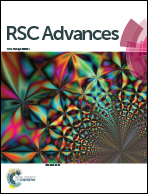Influence of synthesis conditions on the morphologies of ReBO3 microstructures and white light emission of YBO3:Eu3+ phosphors prepared by an oleic acid-assisted hydrothermal method
Abstract
Uniform ReBO3 (Re = Y, Dy, Ho, Er and Yb) spherical microstructures were successfully prepared by an oleic acid (OA)-assisted hydrothermal method. In the preparation process of YBO3, the solvent (water/ethanol) composition, OA amount, pH value, reaction temperature, the mole ratio of Y3+/BO33− and reaction time would affect the shape, size, crystallinity and structure of the prepared sample. Spherical, porous spherical and 3D hexagonal flowers of YBO3 crystals can be prepared by changing the synthesis factors, and their possible formation mechanisms were presented based on the experiment results. It is very interesting that YBO3:3%Eu3+ and YBO3:5%Eu3+ samples prepared by the OA-assisted method display a white light emission under excitation at 394 nm, and the quantum yield of the YBO3:5%Eu3+ sample can reach 44.59%. However, when the excitation wavelength is 270 nm, YBO3:5%Eu3+ shows orange-red emission and the quantum yield can reach 79.73%.These results may open up a new opportunity for YBO3:Eu3+ phosphors in the application of the white light emitting diodes (WLEDs).


 Please wait while we load your content...
Please wait while we load your content...